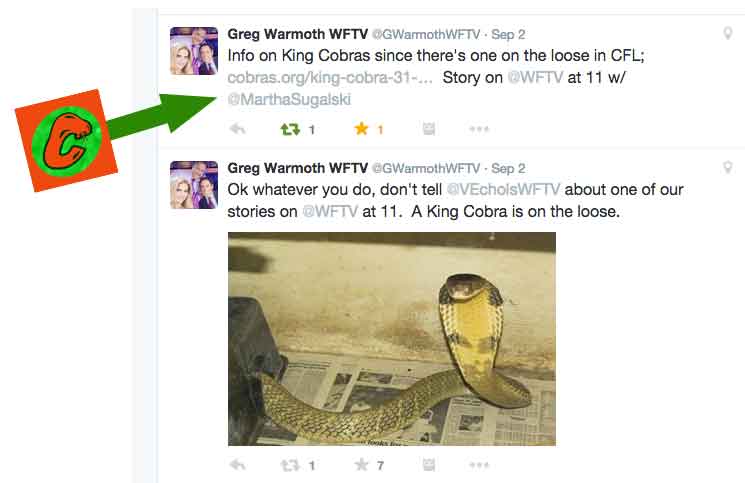Last week, one of the deadliest snakes on the planet, a King Cobra, managed to escape from his owner’s home in Orlando. The story made it immediately to almost every news channel in the world, including CNN and BBC. As the No. 1 online resource on Cobras on the planet, our team here at Cobras.org had our hands full, answering inquiries from journalists and worried citizens. TV Anchor Greg Warmoth from WFTV Channel 9 (an ABC-affiliated TV station) even mentioned us on his Twitter account – as an Info resource (see below the screenshot of Greg Wamoth’s Twitter account).
How fast can it travel? How far can it travel? Where would it be hiding? These were most of the concerned questions we got from citizens who contacted us.
Well, unfortunately there is no data about the average speed of King Cobras. It is quite difficult to measure the speed of any snake in motion, since they never travel in straight lines when moving at their top speeds. As they move forward, in order to find traction on the ground, snakes move their bodies from one side to the other.

However, generally snakes can travel 3-5 miles an hour. We assume Cobras (King Cobra included) would be at the higher part of that range, probably with the ability to travel 5 miles an hour.
As to “Where a King Cobra will go?”, well, the King will always prefer humid locations over arid ones. Its most preferred habitats are dense or open forests in areas near streams or that provide access to bodies of water. If you go searching for one, try looking at bamboo thickets, agricultural areas, dense mangrove swamps and near the water’s edge, where the King will usually search for his prey.
Check out our post about the King Cobra Habitat.
How far and why do snakes travel?
Back to the main concern of the citizens of Orlando, who are still awaiting news as to where the King Cobra is – snakes will travel as far as they must for prey and shelter from weather, especially when it’s cold weather or extreme heat. As the winter season ends and the temperatures slowly rise, snakes will start to become more and more active. They begin by basking in the spring sun, but will not move far from their hibernating spot. As the spring days become warmer on a more consistent manner, the snakes will start to move further away from their hibernating spot, towards their summer habitat. The reasons for moving away are usually to find mates, locate foraging areas and to give birth.
When snakes reach their summer location, they will usually travel only for short distances. Exceptions are some male species that will travel practically anywhere in search of females, in order to mate. As Fall arrives, snakes will slowly start their travel back to their hibernation spots. Many species will return to the exact same location every year, while others will travel for weeks seeking out new habitats to spend their winter.
As we are writing this post, the Florida Fish and Wildlife officials are continuing their search for the mighty King Cobra.



[…] Hundreds of thousands of people started posting all sorts of posts and tweets about the King Cobra snake, some were funny and creative, some alarmed and terrified. We at Cobras.org even had the honor to feature on some TV Host’s Tweet. […]